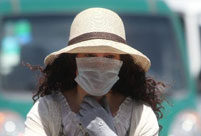 Luoyang aims to become 'Chinese Culture City'
Luoyang aims to become 'Chinese Culture City'
 Century-old jade disc found confirms ancient legend
Century-old jade disc found confirms ancient legend
 A serious mind behind Chinese leader
A serious mind behind Chinese leader
 Panda Cubs to Predict 2014 World Cup Winners
Panda Cubs to Predict 2014 World Cup Winners
 China Southern Airlines flight attendants win titles in service contest
China Southern Airlines flight attendants win titles in service contest
 Pupil's performance art persuades people to stop smoking
Pupil's performance art persuades people to stop smoking
 Nie Chenxi's clay tigers
Nie Chenxi's clay tigers
 Children's Day wishes
Children's Day wishes
 Chinese Kung Fu charms Silicon Valley
Chinese Kung Fu charms Silicon Valley
 Tranquil Yankou ancient town
Tranquil Yankou ancient town
BEIJING, June 6 -- More than 1,300 trainers are prepared to teach local police officers to use firearms correctly, according to the Ministry of Public Security.
The ministry in March launched a program to train officers in the use of firearms in accordance with the law and regulations, and the first group of 30 trainers has been dispatched to Xinjiang Uygur Autonomous Region in northwest China.
Under the ministry's plan, about 10,000 trainers will teach qualified officers to use firearms, with each county-level region having three trainers on average.
Chinese police generally do not carry firearms as gun-related crime is rare in China, where gun controls are strict.
After a series of violent attacks sent shockwaves across the country, Chinese cities have stepped up security. Police in cities including Beijing and Shanghai and the provinces of Yunnan, Hunan, Guangdong and Heilongjiang have increased armed patrols on the streets.
While armed patrolling provides a sense of security for the public, gun misuse and accidents involving police firearms can also happen.
POLICE ARMS
Chinese police pistols were originally designed for combat and were of smaller caliber. The bullets could easily shoot through a target and hurt innocent bystanders.
In 2006, a revolver specially designed for the police was issued to law enforcement departments. With 9 mm metal and rubber bullets, it is less likely to cause collateral injuries in public places.
Professor Wang Lei of the People's Public Security University of China said customized firearms give officers more targeting options.
"The lives of criminals and suspects should also be respected," he said.
Another police weapon is the 38 mm anti-riot shotgun, which can fire tear gas, dye and stun grenades.
SWAT teams and armed police are also equipped with military weapons, such as the Type 95 assault rifle and Type 88 sniper rifle, to handle armed criminals and terrorists.
RULES OF USE
Before the increase in armed patrols, many officers were killed or injured in the line of duty.
In July 2010, a gunman killed two traffic policemen on a highway in Guangdong Province. In January 2011, two police officers and an auxiliary policeman were shot dead during an investigation in Shandong Province.
The police have also come under public criticism in cases of accidental injury and improper use of firearms.
In May this year, the media reported at least three cases of missing police guns. The officers involved were sacked or punished, but public concerns remain.
On May 29, five people were injured after a police officer's gun fired accidentally during a security training session in a kindergarten in central China's Henan Province.
The bullet hit the ground, spraying shrapnel at the arms and legs of four parents and one child.
It was the latest in a string of controversies relating to police firearms.
On Oct. 28, 2013, a policeman shot a couple who ran a noodle restaurant in Pingnan County, Guangxi Zhuang Autonomous Region. The woman and her unborn child died after being hit twice.
Professor Ruan Qilin, of the China University of Political Science and Law, said the misuse of police arms is rare. "We shouldn't tell police officers not to carry guns just because there are a few misuses and missing weapons," he said.
WHEN TO SHOOT
Current laws and regulations about police arms include the People's Police Law, Regulations on Police Weapons, and Regulations on Management and Use of Guns by Public Security Organs.
The Regulations on Police Weapons stipulate 15 situations when an officer can open fire. These include arson, explosions, hijackings and other serious crimes jeopardizing public safety.
Police may shoot if a suspect fails to surrender after police warnings. They may also shoot if there is no time for a warning or when issuing a warning could lead to more deadly consequences.
The Regulations on Police Weapons also list four situations when police should not fire: if a suspect is pregnant or a minor, unless they have committed a violent crime; if a suspect is in a crowded place or a place containing large quantities of flammables, explosives, poisonous or radioactive materials, unless there would be more deadly consequences; if a suspect has stopped the criminal activity; or if a suspect is incapable of committing further crimes.
Despite these rules, the current laws and regulations were written before today's security situation. Some regulations even contradict each other.
Ma Zhenchuan, a deputy to the National People's Congress, China's national legislature, said those regulations could hamper a quick and correct police response to a crime.
Ma cites the Kunming terrorist attack of March 1, when attackers killed 29 people and injured 143 at a railway station in the southwestern city.
"In that case, the police officer who shot four criminals had no right to open fire until the command center authorized him. Our regulations should have given him clear guidance to decide on the spot," said Ma.
 Magnificent Hutiao Gorge
Magnificent Hutiao Gorge  Heat waves hit China
Heat waves hit China Love at the construction site
Love at the construction site Graduation photos bring memories back to life
Graduation photos bring memories back to life Art school students present works in Nanjing
Art school students present works in Nanjing Xinjiang's first high-speed railway goes on trial run
Xinjiang's first high-speed railway goes on trial run 3D Sea-life Themed Art Garage unveiled in Zhengzhou
3D Sea-life Themed Art Garage unveiled in Zhengzhou
 Creative Photos go viral during graduation season
Creative Photos go viral during graduation season Students in last-minute effort for Gaokao
Students in last-minute effort for Gaokao Dali, an ideal summer vacation destination
Dali, an ideal summer vacation destination Xichan Temple's little monk hit the Internet
Xichan Temple's little monk hit the Internet Monologue of a modern dancer
Monologue of a modern dancer College girl proposes to boyfriend on Weibo
College girl proposes to boyfriend on Weibo Special operation members in counter-terrorism training
Special operation members in counter-terrorism training American football brings manhood out of boys
American football brings manhood out of boysDay|Week|Month